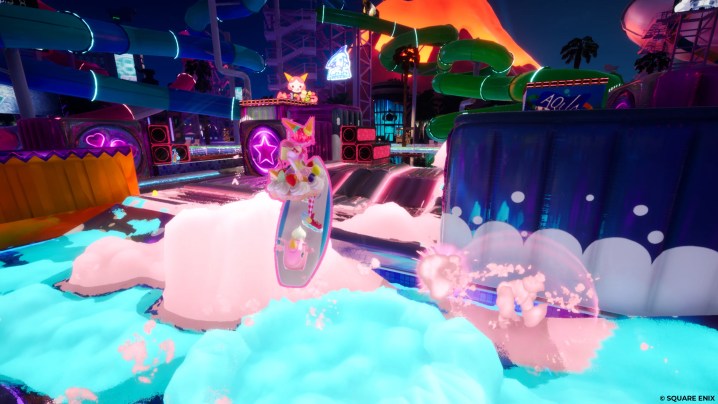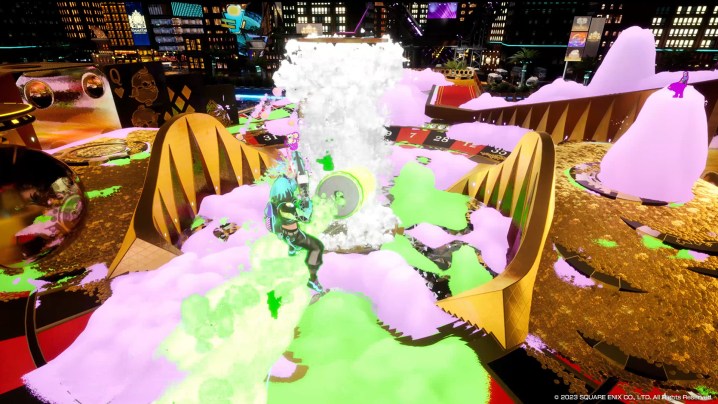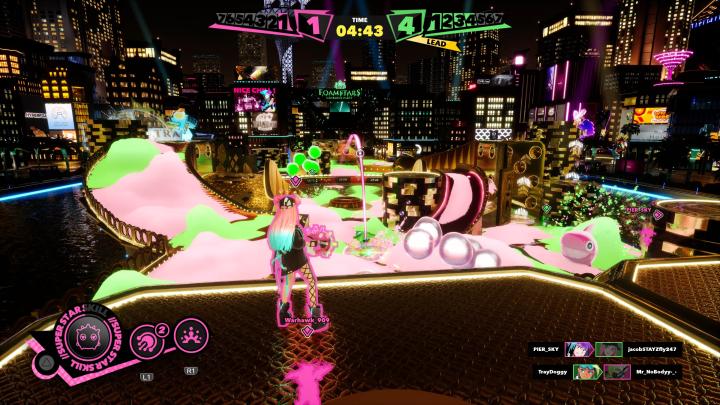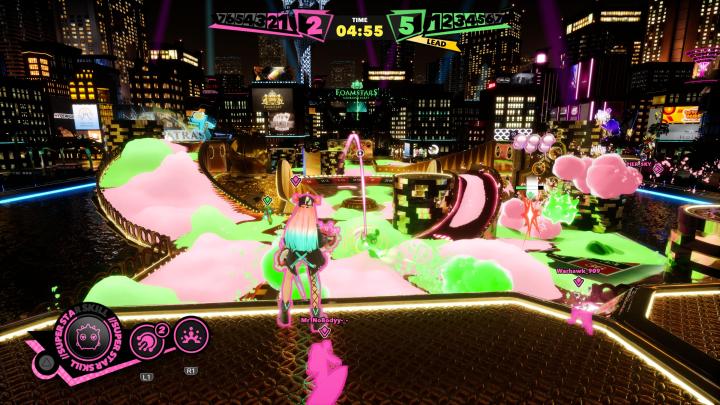
There’s a new multiplayer game in Town: Foamstars. Square Enix’s latest is a riff on Splatoon that trades in ink for suds. I went into it expecting a quirky little arena shooter that would give me a weekend or two of fun before running out of steam as its live-service model began to rear its head. What I wasn’t expecting was a mountain of legibility problems that made it hard for me to tell what I was doing.
The basic idea of Foamstars was always centered around blasting both the arena and opponents with foam in a neon-tinted style reminiscent of Hatsune Miku. While there’s fun to be had in its version of ink-based Splatoon shooting, Foamstars can be an overwhelming explosion of shapes and colors that soaks up all the fun.
Avoid getting into eyes
My first match in Foamstars had the unintentional effect of perfectly replicating what it feels like to get real foam in my eyes. Everything was bright, irritating, and obscured. The only reason I could tell what was happening out the gate was because all players are given an outline in their team’s respective color, as well as an arrow above their heads to let them know what direction to shoot.
These bandaids don’t solve the overarching issue that the game is difficult to parse the second the foam starts flying. No matter which character you pick, the foam bubbles being launched in rapid succession are so massive that your screen will be filled in seconds. When you add in three other teammates and four opponents in a relatively cramped arena, you’d be lucky to see anything but solid colors plastering your screen every few seconds. I found myself turning my character away from the combat at times, desperate for a moment of reprieve from the overwhelming onslaught of visual noise like a man drowning, searching for a single gasp of air.

After the quick tutorial and testing out the small roster of characters, I was hopeful I could have more fun with it than most modern shooters. Despite being a hero shooter, Foamstars keeps things simple. Each character only has one gun, two abilities, and an ultimate. I figured team comps would be basic, and learning what to watch out for from enemies would only take a handful of matches to internalize. This is opposed to Overwatch, which has completely skill-checked me as dozens of heroes and reworks have been added.
A more restrained number of options doesn’t necessarily mean a lack of depth or possibly strategy. I would argue it can even engender a greater level of depth. Unfortunately, it’s tough to know which side of that line Foamstars currently falls on. The visually chaotic nature fights opportunities for strategic play. Every match I’ve played has boiled down to simply lobbing my foam balls at enemies, occasionally throwing out an ability or ultimate, and hoping for the best. I am never thinking beyond how to line my shot up. It doesn’t matter what character I am or which I am fighting at any moment. I’m sure a meta will form as a “pro” scene forms around it, but the visual clutter can make it tough for a casual player to find their footing in a sea of pastels.
Accessibility for none
While I always check out accessibility options for things like switching button taps to holds since my hands aren’t quite what they used to be, I never considered any visual options before. As I struggled with Foamstars, I wondered if there were any colorblind options that could help out. I did find a single colorblind option, but it didn’t help matters much.
The first red flag was the fact that it contained a simple On/Off toggle. That’s lacking compared to games like Doom and Doom Eternal. Both of these games include not just a one-size-fits-all colorblind option but also different options for protanopia, tritanopia, and deuteranopia. I don’t know what type Foamstars‘ mode attempts to satisfy, but it feels sparse for a game whose gameplay loop revolves around color.
Never before have I been so thoroughly convinced that a menu option actually had no function. Here are two screenshots with colorblind mode turned on and off. Just by looking, are you able to tell which is which?
The answer is that the screenshot on the left has colorblind mode on, and the one on the right has it off. The only difference I could tell when reviewing them is that having it off dulls the outline of the foam somewhat but is a completely lacking implementation of such a feature.
The wider acceptance and adoption of accessibility options has been one of the few universally praised pushes in the games industry. I am well aware of how privileged I am to, for the most part, not need them in the same way others do. I also don’t need options to play Foamstars, but a good suite of options could have had a positive side effect for players like me.
As experts in the field will tell you: Accessible design is just good design. Accessibility’s primary focus is, and should be, to allow as many people to play games who otherwise couldn’t. And those changes can often make games more comfortable and approachable to wider audiences who didn’t even know they needed some help. Foamstars fails to do either, and I hope that changes down the line so I can jump back into the party.
Foamstars is available now on PS4 and PS5.
Editors' Recommendations
- PSA: Don’t burn yourself out on Final Fantasy VII Rebirth’s open-world activities
- Visions of Mana: release date window, trailers, gameplay, and more
- Foamstars is coming to PS Plus next month as a freebie
- Ghostrunner 2 is already giving me more of what I loved about the original
- More Black video game heroes shouldn’t be a fantasy






